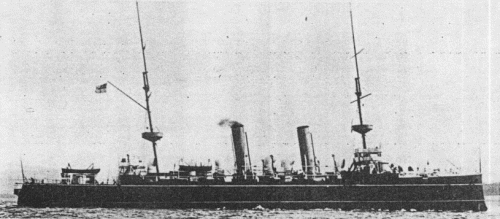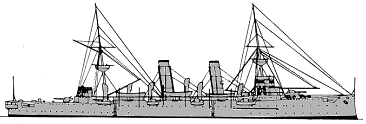
NAVYPEDIA
 Support the project with paypal
Support the project with paypal
Photo

Venus 1904
Ships
| Name | No | Yard No | Builder | Laid down | Launched | Comp | Fate |
|---|---|---|---|---|---|---|---|
| Eclipse | D58 | Portsmouth DYd | 11.12.1893 | 19.7.1894 | 23.3.1897 | submarine depot ship 1916, sold 8.1921 | |
| Talbot | D61, P61, PA7 | Devonport DYd | 5.3.1894 | 25.4.1895 | 15.9.1896 | sold 12.1921 | |
| Venus | P38, P2C | 381 | Fairfield, Govan | 28.6.1894 | 5.9.1895 | 9.11.1897 | sold 9.1921 |
| Minerva | P32, P1A, P7A | Chatham DYd | 4.12.1893 | 23.9.1895 | 4.2.1897 | sold 10.1920 | |
| Juno | N37, N65 | 239 | Naval Construction & Armaments, Barrow | 22.6.1894 | 16.11.1895 | 16.6.1897 | sold 9.1920 |
| Diana | D18, P58, N34 | 382 | Fairfield, Govan | 13.8.1894 | 5.12.1895 | 15.6.1897 | sold 7.1920 |
| Doris | D59, P47 | 240 | Naval Construction & Armaments, Barrow | 29.8.1894 | 3.3.1896 | 18.11.1897 | sold 2.1919 |
| Dido | 283 | London & Glasgow, Glasgow | 30.8.1894 | 20.3.1896 | 10.5.1898 | submarine depot ship 1.1914, sold 12.1926 | |
| Isis | D60, P60, N61 | 284 | London & Glasgow, Glasgow | 30.1.1895 | 27.6.1896 | 10.5.1898 | sold 2.1920 |
Technical data
| Displacement normal, t | 5600 |
|---|---|
| Displacement full, t | |
| Length, m | 106.7 pp 113.7 oa |
| Breadth, m | 16.3 |
| Draught, m | 6.25 |
| No of shafts | 2 |
| Machinery | 3-cyl VTE, 8 cylindrical boilers |
| Power, h. p. | natural draught: 8000, forced draught: 9600 |
| Max speed, kts | natural draught: 18.5, forced draught: 19.5 |
| Fuel, t | coal 1075 |
| Endurance, nm(kts) | 7000(10) |
| Armour, mm | Harvey steel; deck: 76 - 38, gunshields: 76, engine hatch: 152, CT: 152 |
| Armament | 5 x 1 - 152/40 QF Mk I/II, 6 x 1 - 120/40 QF Mk I/II/III/IV, 8 x 1 - 76/40 12pdr 12cwt QF Mk I, 6 x 1 - 47/40 3pdr Hotchkiss Mk I, 2 x 1 - 11.4/94, 3 - 450 TT (2 beam sub, 1 aft aw) |
| Complement | 450 |
Standard scale images

Dido 1898
Graphics
Project history
Following the criticism of earlier second class cruisers the Eclipse class, provided under the Spencer Programme of 1893/94, were designed with a heavier armament but as this was combined with another major increase in size they were subject to as much abuse as their predecessors. The arrangement of hull and protection was the same as that of the Astraea class except that seaworthiness was further improved by the addition of a turtleback forecastle extending as far aft as the foremast. The armament was also arranged like that in Astraea except that the two foremost 120mm guns were replaced by two 152mm, the single 152mm on the quarterdeck was replaced by two sided 152mm and the 57mm guns were replaced by 76mm. This arrangement was chosen to secure the maximum improvement in ahead and astern fire and resulted in broadside fire being a little better than that of Astraea — 3 152mm and 3 120mm compared with 2 152mm and 4 120mm. It was eventually accepted that they were under-gunned for their size and during 1903-05 all except Eclipse were rearmed. Apart from a slight increase in power the machinery was similar to that in Astraea and designed speed and endurance were the same. On trials the ships achieved between 9760 and 9875ihp and speeds of 20 to 21.2kts. With the exception of Talbot they were the first British second class cruisers to be fitted with fighting tops which were positioned low on both masts. Dido and Isis had singie pole masts while the remainder of the class had fidded topmasts.
Ship protection
The protective deck was 38mm thick on the flat and 76mm on the slope, and the engine cylinders, where they projected above this deck, were protected by a 152mm armoured glacis around the engine room hatch.
Modernizations
1903-1905, Talbot, Venus, Minerva, Juno, Diana, Doris, Dido, Isis: - 5 x 1 - 152/40, 6 x 1 - 120/40; + 11 x 1 - 152/45 BL Mk VII
Naval service
Dido collided with cruiser Berwick in 1913 but was quickly repaired and became submarine depot ship; from 1916 until the Armistice she served as depot ship for destroyer flotilla, paid off for disposal in February 1926. Eclipse in 1916 became submarine depot ship, laid up to reserve in 1918. Isis served as Cadets` TS until 1907. Talbot ran aground in the Suez Canal in September 1912, was repaired.
Many thanks to Wolfgang Stöhr for additional information on this page.
 HOME
HOME FIGHTING SHIPS OF THE WORLD
FIGHTING SHIPS OF THE WORLD UNITED KINGDOM
UNITED KINGDOM CRUISERS
CRUISERS ECLIPSE 2 class cruisers (9, 1896 - 1898)
ECLIPSE 2 class cruisers (9, 1896 - 1898)
